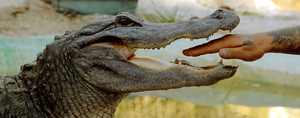Gator Wrestlers Endangered
 Kathleen Kernicky - South Florida Sun-Sentinel Kathleen Kernicky - South Florida Sun-Sentinel


| | "Make one mistake, and they'll get you," says Daniel Fontaine, who makes a living doing things like this at Everglades Holiday Park. (Lou Toman/South Florida Sun-Sentinel) |
Fort Lauderdale, Fla. - At Everglades Holiday Park, on the western edge of Route 27, Daniel Fontaine tends to his nine gators and waits for the tourists to arrive.

Fontaine makes a living wrestling alligators, a job he describes as part stuntman, part showman. He demonstrates by dragging a 10-footer named Seven Toes out of the water by its tail. He taps a smaller gator named Bobber on the nose until it opens its wide jaws and shows its teeth, a move wrestlers call a "Florida smile."

In their heyday, alligator wrestlers could earn $1,000 a week in tips.

"I did a show the other day, 19 people. I made $3," said Fontaine, who learned to wrestle gators as a teenager in the Louisiana swamps. "Today, it's hard to find alligator wrestlers. There aren't many of us left anymore. It's a dying breed."

For almost a century, alligator wrestling was a fixture at Florida's roadside parks, river docks and Native American villages. Now, the shows are skidding onto the endangered list.

There are many reasons. The Seminoles, who wrestled gators for tourists on the Miami River as far back as 1919, have moved into more lucrative and less dangerous professions, with diverse business empires such as gaming, hotels and cattle.

Theme parks such as Disney World have diverted tourists' attention. And there are animal-rights activists and stricter regulations, as well as alligator shows on the Internet.

"A lot of places still keep gators on display, but the number of live shows is in decline," said James Peacock, 36, wildlife manager at Seminole Native Village, a tourist spot with daily gator shows in Hollywood, Fla. "With the birth of the Internet, people don't need to come to a park and pay an entrance fee when they can go online and see 30 alligator-wrestling shows today."

Long before the shows, Seminoles hunted alligators for food.

"We had to live off whatever Mother Nature provided us in the Everglades," said Max Osceola, a Seminole tribal councilman. "We'd eat the tail, the meaty part. . . . Later on, when the alligator skin had a value, we would hunt and skin the gators and bring the skin to trading posts and trade for things we couldn't grow."

By the end of World War I, young Seminoles were wrestling gators for tips at Musa Isla, a tourist attraction on the Miami River, said Patsy West, the Fort Lauderdale author of The Enduring Seminoles: From Alligator Wrestling to Ecotourism. The alligator shows were shown on newsreels in the nation's movie theaters, luring tourists to the Florida attraction.

Osceola remembers greeting them as they got off the boats on the New River in the 1950s.

"We'd sing 'Jesus Loves Me' in Seminole and say the Pledge of Allegiance in English. After that, there'd be an alligator pit. The men would go in there, and they'd put on an alligator-wrestling show. They'd pass the hat, and the tourists would tip the men."

By the 1960s, wrestlers would dive into six feet of water, grab the gator by the jaws and belly, and pull it out.

Today, "our young people, instead of learning how to wrestle alligators, we send them to school," Osceola said.

"Alligator wrestling is part of our history; we're proud of that. . . . But we also want people to know that we have progressed. . . . We don't want to lose a digit. We want to earn digits," Osceola said, chuckling.

At 54, Fontaine, who is part Abenaki Indian, figures he's getting too old to be sticking his head inside an alligator's jaws. His life-insurance policy was already canceled.

Fontaine has 19 bite scars, and his left pinkie is permanently bent. He lost part of his chin to a bite when a child threw a rock during a show and spooked a gator. He has been heckled and spit upon by animal-rights activists.

So why does he do it?

"It's an adrenaline rush. That's why I like it. . . . Make one mistake and they'll get you. Get distracted, or put your hand up, they're going to know. You're tired and not feeling strong, they'll know. They're stronger than you are. If you mess up, you're gonna get bit." |



